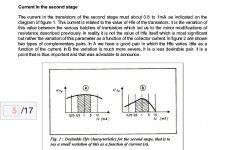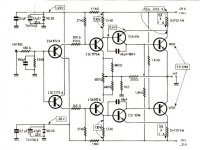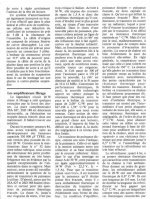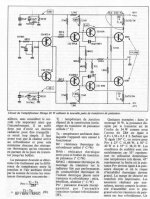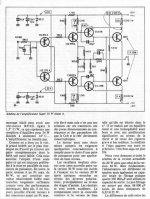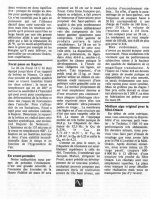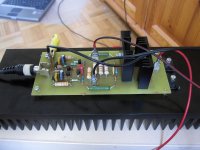Hi, on my 30W version 0,63V (bias=1,57A across 0,4 om collector's resistors).
BJT:
2SC1775E+2SA872E, MJE15034G+MJE15035G, MJL3281A+MJL3281AG. (with Hitachi 1775+872 to my ears the sound a little better, than with ON Semi BC550CG+BC560CG).
p/s: using Philips BC550C+ON Semi BC560CG was bad idea.
You are right, but i used bc550/560c from NXP wich are the closest thing to the in the HFE region of 1mA (it is flat at 1mA just like J.Hiraga mentioned) like the hitachi pair:
Nxp-- http://cygnus.et.put.poznan.pl/~kklima/aue/BC549_550.pdf
Hitachi-- http://datasheet.octopart.com/2SA872-Hitachi-datasheet-101859.pdf
The Philips pair is close too:
http://www.jm.pl/karty/BC549.pdf
The onsemi is not that good, look at the HFE graph (the hfe goes up from 1mA and Up):
http://www.farnell.com/datasheets/727135.pdf
Farichild is good too BUT has very big COB (not good at all):
https://www.fairchildsemi.com/datasheets/bc/bc547.pdf
The ksa 992 is very good but the HFE Goes down from 1mA and up, so not my choice:
https://www.fairchildsemi.com/datasheets/bc/bc547.pdf
The desirable pair is the NOS Hitachi or NEC 2sa/2sc or nxp or philips BC...
The HFE influences the amp at clipping so it is desirable to be almost flat like the Hitachi pair.
Cheers
Sergiu
Last edited:
You are right, but i used bc550/560c from NXP wich are the closest thing to the in the HFE region of 1mA (it is flat at 1mA just like J.Hiraga mentioned) like the hitachi pair:
Nxp-- http://cygnus.et.put.poznan.pl/~kklima/aue/BC549_550.pdf
Hitachi-- http://datasheet.octopart.com/2SA872-Hitachi-datasheet-101859.pdf
The Philips pair is close too:
http://www.jm.pl/karty/BC549.pdf
The onsemi is not that good, look at the HFE graph (the hfe goes up from 1mA and Up):
http://www.farnell.com/datasheets/727135.pdf
Farichild is good too BUT has very big COB (not good at all):
https://www.fairchildsemi.com/datasheets/bc/bc547.pdf
The ksa 992 is very good but the HFE Goes down from 1mA and up, so not my choice:
https://www.fairchildsemi.com/datasheets/bc/bc547.pdf
The desirable pair is the NOS Hitachi or NEC 2sa/2sc or nxp or philips BC...
Cheers
Sergiu
Try to find NEC 2SC1845+2SA992.
Try to find NEC 2SC1845+2SA992.
I'm sorry my friend but i dont have a valid source for the obsolete Hitachi pair. I dont want the KSA substitute because they are not as good as the Hitachi or Nec..
I'm sorry my friend but i dont have a valid source for the obsolete Hitachi pair. I dont want the KSA substitute because they are not as good as the Hitachi or Nec..
BC550C+BC560C Philips/NXP very good too, much better, than Fairchild's BJT.
BC550C+BC560C Philips/NXP very good too, much better, than Fairchild's BJT.
I think ON Semi is better if can get them.
I think ON Semi is better if can get them.
I like ON Semi BC550CG+BC560CG, but Hitachi 2SC1775E+2SA872E is better.
Hi Gaborbela,I think ON Semi is better if can get them.
In the atached picture you will see what i was talking about. The desired hfe curve for the input pair was described in L'audiofille No15, page 5/17. Look at the picture bellow.
Thats why i said that ksa/ksc pair equivallent or Onsemi or fairchild is not so good as a substitute for the hitachi/nec 2sa/2sc best but obsolete pair...
The philips/nxp are closest but they are obsolete now too.
We have to find other substitutes...
Cheers
Sergiu
Attachments
Here is the ksa/ksc equivalent from Fairchild :
http://www.mouser.com/ds/2/149/KSA992-88789.pdf
Its not even close to the original pair at the hfe chapter..
http://www.mouser.com/ds/2/149/KSA992-88789.pdf
Its not even close to the original pair at the hfe chapter..
Here is the ksa/ksc equivalent from Fairchild :
http://www.mouser.com/ds/2/149/KSA992-88789.pdf
Its not even close to the original pair at the hfe chapter..
Sorry, but Fairchild's transistors can't be equivalent, because it's Fairchild.
Maybe to use ON SEMI BC550CG+BC560CG.
Last edited:
Member
Joined 2009
Paid Member
The desired hfe curve for the input pair was described in L'audiofille No15, page 5/17. Look at the picture bellow.
I was always fascinated by this advice. I've used it recently in my JLH69 Class A amplifier - as a result I used 8 parallel output devices so I could operate them at the peak of their Hfe curves and where the curves are relatively flat. It stabilizes the OPS input impedance as seen from the driving stage.
I think ON Semi is better if can get them.
Did you build Hiraga's 20W version (Jan.,1985)?
Attachments
Yes but with out the tantalum capacitors.
Also I replaced the driver stage with ON Semi MJE 15024 & 15025
The NEC drivers are to soft and a bit muddy. I had the original NEC output transistors but after some test I sold those with the drivers together.
On the input I never used anything else just the recommended Hitachi.
Transistor behaviour is important of course I do not deny that but I do not have access to measure them so I use my ear and A-B test.
Greetings
Also I replaced the driver stage with ON Semi MJE 15024 & 15025
The NEC drivers are to soft and a bit muddy. I had the original NEC output transistors but after some test I sold those with the drivers together.
On the input I never used anything else just the recommended Hitachi.
Transistor behaviour is important of course I do not deny that but I do not have access to measure them so I use my ear and A-B test.
Greetings
Yes but with out the tantalum capacitors.
Also I replaced the driver stage with ON Semi MJE 15024 & 15025
The NEC drivers are to soft and a bit muddy. I had the original NEC output transistors but after some test I sold those with the drivers together.
On the input I never used anything else just the recommended Hitachi.
Transistor behaviour is important of course I do not deny that but I do not have access to measure them so I use my ear and A-B test.
Greetings
Big thanx for information, but what better: 20W (1985) or 30W (1985)?
I read a few pages of this thread. I am interested in Class A amplifier. The Haraga design is very different from the common 2EF or 3EF design. Can anyone point to some article of the theory of operation and comparing between this and the 3EF OPS?
Thanks
There is a little information about Jean Hiraga's Super Class A 20W & 30W Amplifiers. The 30W version has very very good sound, but I want to build 20W version.
Attachments
There is a little information about Jean Hiraga's Super Class A 20W & 30W Amplifiers. The 30W version has very very good sound, but I want to build 20W version.
Beware, the bottom Zener is inverted in these original schematics.
I have built the Hiraga super Class A as described here.
Sounds real nice but runs veeeeeery hot!
Cheers,
Jacques
Beware, the bottom Zener is inverted in these original schematics.
I have built the Hiraga super Class A as described here.
Sounds real nice but runs veeeeeery hot!
Cheers,
Jacques
This is Class A.
Beware, the bottom Zener is inverted in these original schematics.
I have built the Hiraga super Class A as described here.
Sounds real nice but runs veeeeeery hot!
Cheers,
Jacques
Maximum temperature was +53C in summer (+28 in room) with bias 1,75A. Each radiator is approximately 5000 sq.cm.
Maximum temperature was +53C in summer (+28 in room) with bias 1,75A. Each radiator is approximately 5000 sq.cm.
I used a 30x10x4cm massive heatsink (biggest available in my shop) biased at 1.65A @ 35V and temperature exceeded 55°C: could not touch heatsink more than a few seconds.
Definitely not ecological
Attachments
I used a 30x10x4cm massive heatsink (biggest available in my shop) biased at 1.65A @ 35V and temperature exceeded 55°C: could not touch heatsink more than a few seconds.
Definitely not ecological
Aaa... But +55C is not big, it's ideal temperature, I've think.
p.s.: good heatsink.
Last edited:
- Status
- This old topic is closed. If you want to reopen this topic, contact a moderator using the "Report Post" button.
- Home
- Amplifiers
- Solid State
- Hiraga 20W class A
